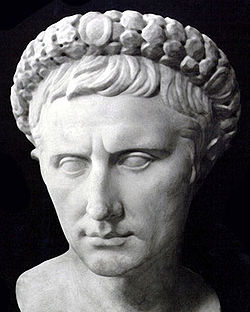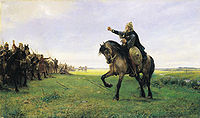
Kjárr
Encyclopedia

Norse mythology
Norse mythology, a subset of Germanic mythology, is the overall term for the myths, legends and beliefs about supernatural beings of Norse pagans. It flourished prior to the Christianization of Scandinavia, during the Early Middle Ages, and passed into Nordic folklore, with some aspects surviving...
that is believed to be the reflection of the Roman Emperor
Roman Emperor
The Roman emperor was the ruler of the Roman State during the imperial period . The Romans had no single term for the office although at any given time, a given title was associated with the emperor...
s. In Old Norse
Old Norse
Old Norse is a North Germanic language that was spoken by inhabitants of Scandinavia and inhabitants of their overseas settlements during the Viking Age, until about 1300....
sources, he appears as a king of the Valir
Walha
Walhaz is a reconstructed Proto-Germanic word, meaning "foreigner", "stranger", "Roman", "Romance-speaker", or "Celtic-speaker". The adjective derived from this word can be found in , Old High German walhisk, meaning "Romance", in Old English welisċ, wælisċ, wilisċ, meaning "Romano-British" and in...
(Celtic/Romance southerners) who were the people of Valland
Valland
In Norse legend Valland is the name the part of Europe which is inhabited by Celtic and Romance speaking peoples. The element Val- is derived from Walha, a Germanic root meaning "foreigner", usually applied to the Celtic and Italic inhabitants of Europe....
(the Celtic/Roman south).
Many scholars have suggested that the name is derived from Caesar
Caesar (title)
Caesar is a title of imperial character. It derives from the cognomen of Julius Caesar, the Roman dictator...
, but the route it took to Scandinavia
Scandinavia
Scandinavia is a cultural, historical and ethno-linguistic region in northern Europe that includes the three kingdoms of Denmark, Norway and Sweden, characterized by their common ethno-cultural heritage and language. Modern Norway and Sweden proper are situated on the Scandinavian Peninsula,...
is not clear. It may have been transmitted through a West Germanic language
West Germanic languages
The West Germanic languages constitute the largest of the three traditional branches of the Germanic family of languages and include languages such as German, English, Dutch, Afrikaans, the Frisian languages, and Yiddish...
, but since Scandinavia and the Goths
Goths
The Goths were an East Germanic tribe of Scandinavian origin whose two branches, the Visigoths and the Ostrogoths, played an important role in the fall of the Roman Empire and the emergence of Medieval Europe....
had close connections, it may also have been borrowed from the Gothic language
Gothic language
Gothic is an extinct Germanic language that was spoken by the Goths. It is known primarily from the Codex Argenteus, a 6th-century copy of a 4th-century Bible translation, and is the only East Germanic language with a sizable Text corpus...
and ultimately from Greek
Greek language
Greek is an independent branch of the Indo-European family of languages. Native to the southern Balkans, it has the longest documented history of any Indo-European language, spanning 34 centuries of written records. Its writing system has been the Greek alphabet for the majority of its history;...
. The evolution of the name would have been καισαρ → kaisar → *kēsar → Kíarr → Kiárr. A third possibility is that it originates from contacts with Rome beside the probably early borrowing Rúm in words such as Rúmverjar ("Roman soldiers").
A perhaps less common view holds that it stems from Old Irish Kíarr or from Cearbhall of Valland (Wales
Wales
Wales is a country that is part of the United Kingdom and the island of Great Britain, bordered by England to its east and the Atlantic Ocean and Irish Sea to its west. It has a population of three million, and a total area of 20,779 km²...
).
In his Skáldskaparmál
Skáldskaparmál
The second part of Snorri Sturluson's Prose Edda the Skáldskaparmál or "language of poetry" is effectively a dialogue between the Norse god of the sea, Ægir and Bragi, the god of poetry, in which both Norse mythology and discourse on the nature of poetry are intertwined...
, Snorri Sturluson
Snorri Sturluson
Snorri Sturluson was an Icelandic historian, poet, and politician. He was twice elected lawspeaker at the Icelandic parliament, the Althing...
lists Kjárr as a descendant of Auði
Auðr
In Norse mythology, Auðr is the son of the personified night, Nótt, fathered by Naglfari. Auðr is attested in the Prose Edda, written in the 13th century by Snorri Sturluson, and in the poetry of skalds.-Attestations:...
, the founder of the Ödling dynasty:
[...] þriði Auði, er Öðlingar eru frá komnir, [...] Af Niflunga ætt var Gjúki, af Öðlinga ætt var Kjárr, af Ylfinga ætt var Eiríkr inn málspaki. |
[...] Audi, from whom the Ödlungs are come; [...] Of the Niflung Nibelung The German Nibelungen and the corresponding Old Norse form Niflung is the name in Germanic and Norse mythology of the royal family or lineage of the Burgundians who settled at Worms.... 's house was Gjúki Gjúki Gjúki was the King of the Burgundians in the late 4th century until his death in or around 407. He was the father of Gundomar I, Giselher, and Gunther.... ; of the house of Ödlings, Kjárr; of the house of the Ylfings was Eiríkr the Wise in Speech. |
In the genealogy section of Hversu Noregr byggðist, further information is provided about Auði and Kjarr. It presents Auði as the grandfather of Kjarr and as an early ruler of the Celtic/Romance southerners:
Auði hafði Valland ok var faðir Fróða, föður Kjárs, föður Ölrúnar. |
Auði ruled Valland and was the father of Fróði, the father of Kjár, the father of Ölrún Alruna Alruna is a Germanic female personal name, from Proto Germanic *aliruna, from ali- "strange" and runa "secret", rune... . |

Alruna
Alruna is a Germanic female personal name, from Proto Germanic *aliruna, from ali- "strange" and runa "secret", rune...
also appear in the Völundarkviða
Völundarkviða
Völundarkviða is one of the mythological poems of the Poetic Edda...
, where she is a Valkyrie
Valkyrie
In Norse mythology, a valkyrie is one of a host of female figures who decides who dies in battle. Selecting among half of those who die in battle , the valkyries bring their chosen to the afterlife hall of the slain, Valhalla, ruled over by the god Odin...
who marries the master archer Egil
Agilaz
Egil is a legendary hero of the Völundarkviða and the Thidreks saga. The name is from Proto-Germanic *Agilaz, and the same legend is reflected in Old English Ægil of the Franks Casket and Alamannic Aigil of the Pforzen buckle....
, the brother of Wayland the Smith
Weyland
In Germanic and Norse mythology, Wayland the Smith is a legendary master blacksmith. In Old Norse sources, Völundr appears in Völundarkviða, a poem in the Poetic Edda, and in Þiðrekssaga, and his legend is also depicted on the Ardre image stone VIII...
:
Þar váru tvær dætr Hlöðvés konungs, Hlaðguðr svanhvít ok Hervör alvitr, in þriðja var Ölrún Kjársdóttir af Vallandi. Þeir höfðu þær heim til skála með sér. Fekk Egill Ölrúnar, en Slagfiðr Svanhvítrar, en Völundr Alvitrar. Þau bjuggu sjau vetr. Þá flugu þær at vitja víga ok kómu eigi aftr. Þá skreið Egill at leita Ölrúnar, en Slagfiðr leitaði Svanhvítrar, en Völundr sat í Úlfdölum. Hann var hagastr maðr, svá at menn viti, í fornum sögum. |
Two of them were daughters of King Hlothver, Hlathguth the Swan-White and Hervor the All-Wise, and the third was Olrun, daughter of Kjar from Valland. These did they bring home to their hall with them. Egil took Olrun, and Slagfith Swan-White, and Völund All-Wise. There they dwelt seven winters; but then they flew away to find battles, and came back no more. Then Egil set forth on his snowshoes to follow Olrun, and Slagfith followed Swan White, but Völund stayed in Ulfdalir. He was a most skillful man, as men know from old tales. |
There are two other references which both place Kjarr far back in time as a contemporary of the Huns
Huns
The Huns were a group of nomadic people who, appearing from east of the Volga River, migrated into Europe c. AD 370 and established the vast Hunnic Empire there. Since de Guignes linked them with the Xiongnu, who had been northern neighbours of China 300 years prior to the emergence of the Huns,...
during the Age of Migrations. One of these is a poem in the Poetic Edda
Poetic Edda
The Poetic Edda is a collection of Old Norse poems primarily preserved in the Icelandic mediaeval manuscript Codex Regius. Along with Snorri Sturluson's Prose Edda, the Poetic Edda is the most important extant source on Norse mythology and Germanic heroic legends, and from the early 19th century...
named Atlakviða
Atlakviða
Atlakviða is one of the heroic poems of the Poetic Edda. One of the main characters is Atli who originates from Attila the Hun. It is one of the most archaic Eddic poems. It is preserved in the Codex Regius and the same story is related in the Völsunga saga...
:
|
|

Hervarar saga
Hervarar saga ok Heiðreks is a legendary saga from the 13th century combining matter from several older sagas. It is a valuable saga for several different reasons beside its literary qualities. It contains traditions of wars between Goths and Huns, from the 4th century, and the last part is used as...
which contains a reference to Kíarr in a poem in fornyrðislag which lists the great kings of old:
|
Huns The Huns were a group of nomadic people who, appearing from east of the Volga River, migrated into Europe c. AD 370 and established the vast Hunnic Empire there. Since de Guignes linked them with the Xiongnu, who had been northern neighbours of China 300 years prior to the emergence of the Huns,... did rule, Gizur Gizur, Gizurr or Gissur was a King of the Geats. He appears in The Battle of the Goths and Huns, which is included in the Hervarar saga and in editions of the Poetic Edda... the Gauts Geat Geats , and sometimes Goths) were a North Germanic tribe inhabiting what is now Götaland in modern Sweden... , Goths The Goths were an East Germanic tribe of Scandinavian origin whose two branches, the Visigoths and the Ostrogoths, played an important role in the fall of the Roman Empire and the emergence of Medieval Europe.... Angantyr Angantyr Angantyr was the name of three characters from the same line in Norse mythology, and who appear in Hervarar saga, in Gesta Danorum and Faroese ballads.... , Valdar Valdar was the name of one or several legendary Danish kings.-Hervarar saga:The Hervarar saga tells that Ivar Vidfamne made Valdar the viceroy of Denmark and gave him his daughter Alfhild. When Valdar died, his son Randver became the king of Denmark, while his son Harald Wartooth became the king of... the Danes Daner The Danes were a North Germanic tribe residing in modern day Denmark. They are mentioned in the 6th century in Jordanes' Getica, by Procopius, and by Gregory of Tours.... , |
The few appearances of Kjárr stand out from the general lack of references to the Romans
Roman Empire
The Roman Empire was the post-Republican period of the ancient Roman civilization, characterised by an autocratic form of government and large territorial holdings in Europe and around the Mediterranean....
in the literary sources of the Germanic peoples
Germanic peoples
The Germanic peoples are an Indo-European ethno-linguistic group of Northern European origin, identified by their use of the Indo-European Germanic languages which diversified out of Proto-Germanic during the Pre-Roman Iron Age.Originating about 1800 BCE from the Corded Ware Culture on the North...
before the arrival of Christianity.

